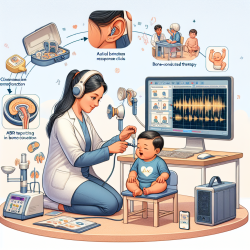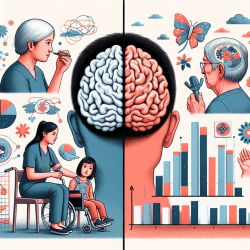Empowering Practitioners: Transforming Challenges into Opportunities
In the realm of speech-language pathology, the intersection of neurological disorders and therapeutic interventions presents both challenges and opportunities. The recent case study, "Rapidly Progressive Locked-in Syndrome Secondary to Atypical Herpes Simplex Virus-1 Rhombencephalitis in an Immunocompromised Individual," offers valuable insights that can enhance our understanding and approach to complex cases. As practitioners dedicated to improving outcomes for children, integrating these insights into our practice is crucial.
Understanding the Case
The case study details a 61-year-old man with chronic lymphocytic leukemia (CLL) who developed locked-in syndrome due to atypical herpes simplex virus-1 (HSV-1) rhombencephalitis. This condition, though rare, highlights the profound impact of viral infections on the central nervous system, particularly in immunocompromised individuals. The patient's rapid neurological decline underscores the need for timely diagnosis and intervention.
Implications for Speech-Language Pathologists
For speech-language pathologists, this case emphasizes the importance of recognizing atypical presentations of neurological conditions. The involvement of the brainstem, particularly the pons, can lead to severe neuro-ocular and neuro-bulbar deficits, impacting speech and swallowing functions. Understanding these implications allows practitioners to tailor their assessments and interventions more effectively.
Data-Driven Decision Making
Data-driven decision making is at the core of effective therapeutic interventions. The case study provides a wealth of data on the progression of HSV-1 rhombencephalitis and its impact on neurological function. By analyzing this data, practitioners can develop targeted strategies to address specific deficits. For instance, the presence of locked-in syndrome necessitates alternative communication methods, such as eye-tracking technology, to facilitate interaction and engagement.
Encouraging Further Research
This case also serves as a catalyst for further research. Understanding the mechanisms behind atypical presentations of HSV-1 encephalitis in immunocompromised individuals can inform the development of new therapeutic approaches. Speech-language pathologists are encouraged to collaborate with interdisciplinary teams to explore innovative solutions that enhance patient outcomes.
Leveraging Technology in Therapy
At TinyEYE, we are committed to leveraging technology to deliver effective online therapy services to schools. The insights gained from this case study can inform the development of digital tools that support communication and cognitive rehabilitation for individuals with severe neurological impairments. By integrating cutting-edge technology into our practice, we can empower children to overcome communication barriers and achieve their full potential.
Conclusion
The case of rapidly progressive locked-in syndrome secondary to atypical HSV-1 rhombencephalitis challenges us to think critically and creatively about our therapeutic approaches. By embracing data-driven decision making, encouraging further research, and leveraging technology, we can transform challenges into opportunities for growth and innovation. As practitioners, our commitment to improving outcomes for children drives us to continuously seek new knowledge and strategies.
To read the original research paper, please follow this link: Rapidly progressive locked-in syndrome secondary to atypical herpes simplex virus-1 rhombencephalitis in an immunocompromised individual.










